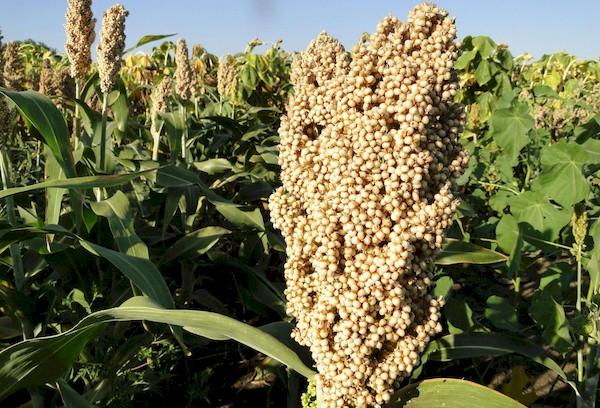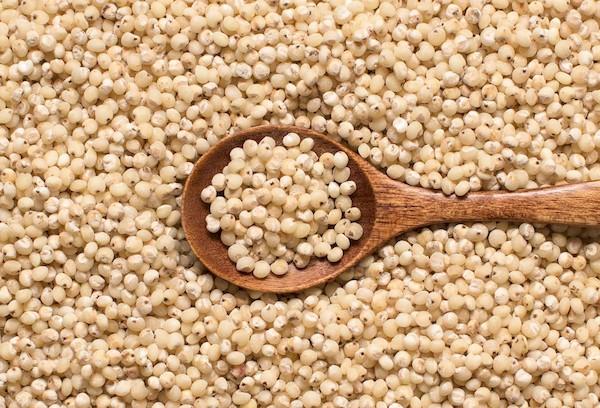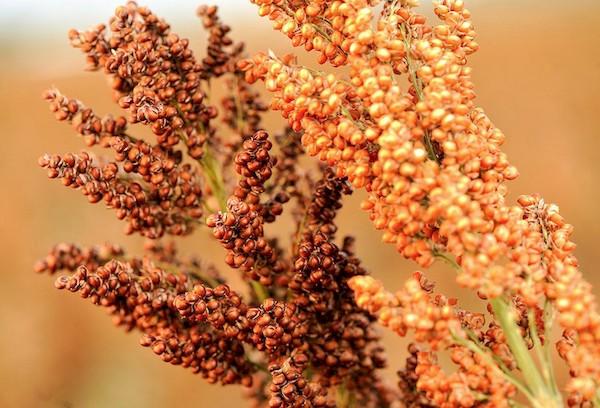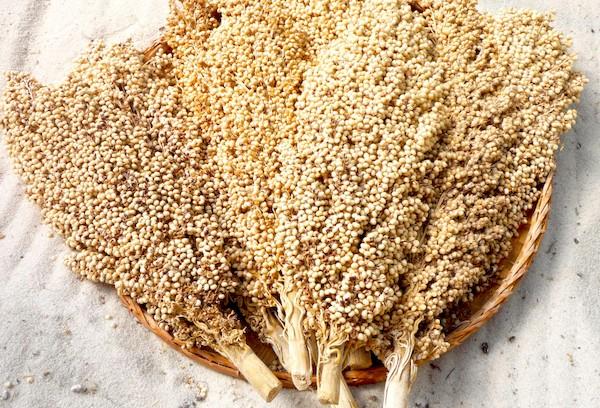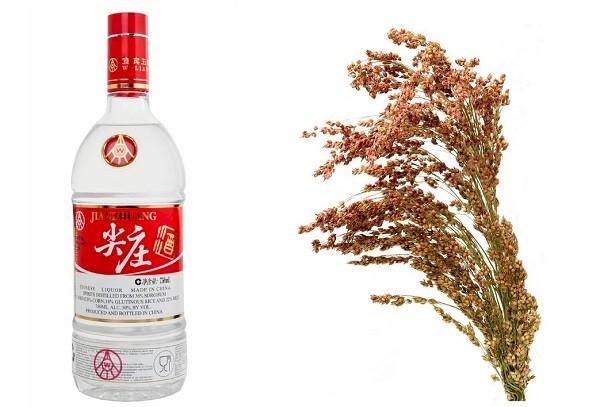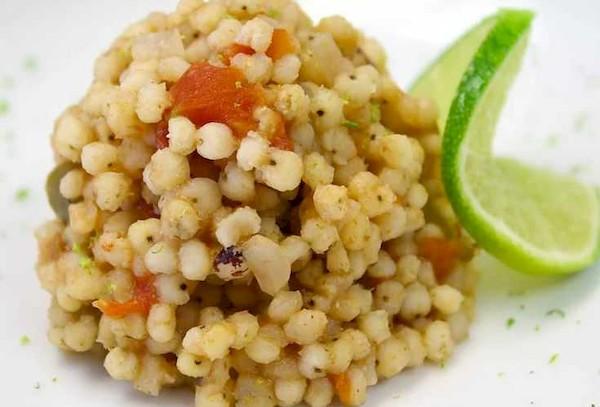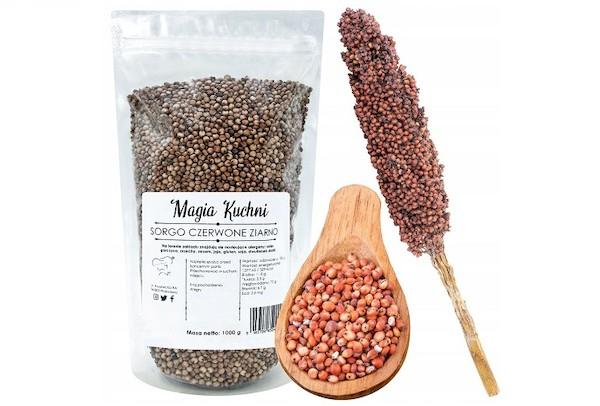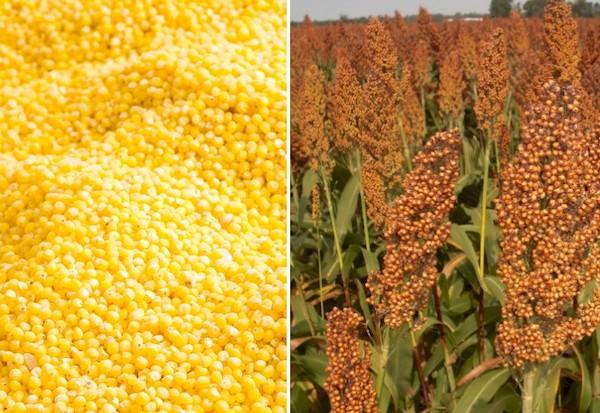Sorghum - what is it, what is made from it, what is it used for?
Content:
Sorghum is increasingly found on store shelves, and many people are at a loss as to what kind of grain it is. There is a certain similarity with millet - the same dot in the center and yellowish color catches the eye. The peculiarity of the plant from which the grain is obtained is its extraordinary drought resistance and high sugar content. Sorghum grain does not contain gluten and is multi-purpose.
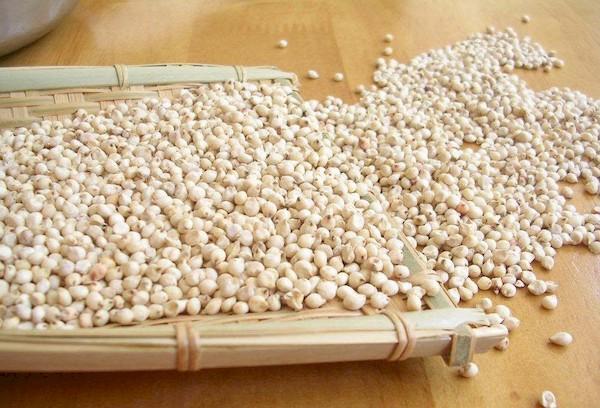
The porridge cooked from it is not like others, very pleasant and slightly nutty. The consistency is similar to corn kernels, brown rice and whole wheat.
What is sorghum grain made from?
The product belongs to cereals. Cereals are made from the same-named annual plant of the Poaceae family, which in appearance resembles corn. The crop can reach a height of 4 m, is very productive and drought-resistant, and has about 100 species. Photo:
The seeds are in a dense inflorescence - a panicle with short branches, and are enclosed in a hard, dense shell.
Photo of grain:
Sorghum is thermophilic, resistant to heat and drought, and does not tolerate frost. His homeland is Africa. It also grows wild in southwest Asia, America, Australia, and southern Europe.Cereals are also grown in the southern regions of Russia, Kazakhstan, Moldova, Ukraine, as well as in India and China. But the leader in production is the USA.
Interesting fact. Sorghum is called the camel of the plant world because of its ability to survive for a long time without moisture, and this in heat up to +40 degrees. It stops its growth, but does not die.
The plant is used for many things: the grain is used not only for cereals, but also serves to make starch, flour, and alcohol. Greens of certain varieties are used for livestock feed and silage. Dry parts serve as fuel, straw - for making brooms, wickerwork, inflorescences - raw materials for red paint for leather, and wax. Sugar syrup, paper, and fabric are produced from the plant. The lemon variety is used as a spice.
Interesting fact. In the USSR there was a classification of sorghum: grass, sugar (contains up to 20% sugars), technical broom, grain.
What is contained in 100 grams
The composition of sorghum is close to corn grits. The grain accumulates up to 70% starch, up to 15% protein rich in lysine, and up to 4% fat.
100 grams contain:
- carbohydrates – 68.3 g;
- proteins – 11.3 g;
- fat – 3.3 g;
- water – 9.2 g;
- ash – 1.57 g.
The calorie content of the raw product is 339 kcal, the glycemic index is 70 units.
Sorghum is rich in B vitamins, folic acid, minerals K, Ca, Si, Mg, Na, Ph, Fe, Co, Mn, Cu, Zn, tannins, antioxidants, phenolic acids, phytosterols, anthocyanins.
Kinds
Several plant varieties are used to produce cereals:
- common sorghum (most widely represented in Russia)
- durra (Sorghum durra, durro, milo, bread sorghum);
- dokhna (Sorghum dochna, grain);
- jugara (Sorghum cernuum, white durra);
- gaoliang (Sorgum nervosum, Chinese, early ripening sorghum).
What kind of grain is there:
- feed - used in agriculture as feed for animals and birds, and is also eaten with pleasure by fish: carp, silver carp, crucian carp;
- food - used for the production of cereals.
Grains can have different colors, they are white, orange, red, brown, black (has the greatest antioxidant activity). The shape also varies: round, oval, ovoid, elongated. The size varies from 5 mm to 3 cm.
In stores, crushed cereals are most often found, since whole grains take a very long time to cook. First you have to soak it for 6 hours and then cook it in salted water for about an hour.
What is prepared from sorghum grains: 10 popular dishes
Sorghum flour is very popular in the food industry, which makes it possible to produce gluten-free semi-finished products and sweets. The grain is used to make crunchy flakes. It is also used to make a special Chinese drink, Maotai - vodka, with a strength of 53-55%, which began to be considered a “national” drink under Mao Zedong, or as they also say, a “diplomatic drink”. Maotai is quite expensive and is consumed mainly for celebrations. The second most popular drink made from sorghum is Chinese vodka Fen-chiu.
Cereals are popular mainly in Asia and Africa.
What is most often prepared from it:
- rice dishes (mix a small amount of sorghum grains for a refined and bright taste);
- legume dishes with the addition of sorghum;
- sorghum with stewed vegetables;
- porridge as a side dish for poultry, offal and seafood;
- additive to soups;
- milk porridge;
- gluten-free sorghum flour pancakes;
- gluten-free dumplings, dumplings and noodles;
- gluten-free pastries, pies and cakes;
- gluten free cookies.
The flour made from this cereal is white or beige, has a soft texture, is tender and slightly sweet in taste. It contains a lot of starch, and to make the dough viscous, knead it correctly in hot liquid. The dough is prepared both sweet and salty. African peoples often bake flatbreads that are used instead of bread.
You can make an excellent coffee substitute from the beans. To do this, the purified cereal is fried in a frying pan until light brown and ground in a coffee grinder. Brew in the following proportion: 2 tsp. sorghum, 1 tsp. sugar, 100 ml water. The drink is filtered before drinking.
Fresh sorghum grains are loved by raw foodists. They eat them raw. The groats are not much harder than nuts, and have a certain taste similarity to walnuts. For greater softness, the product is soaked.
How to choose quality cereals in the store
Sorghum is still quite rare in regular food supermarkets and stores. The grain is mainly produced to feed livestock. Raw foodists and vegetarians buy high-quality cereals in specialized stores. It can also be found in the gluten-free food aisles. A large assortment of cereals is available on Valberis, Ozone and other marketplaces.
How to choose quality sorghum:
- Please note that the grain is food grade, not feed or seed grain.
- Keep in mind that colored unpolished grain will take the longest to cook and will remain crumbly and quite dense.
- White polished sorghum cooks faster and is softer. It retains its shape and has a more delicate taste.
- Crushed cereal is ideal for milk porridges, baby food, and quick cooking.
- An indicator of quality is beautiful, uniform grain, absence of debris and foreign odors.
What is the difference between sorghum and millet grains?
The sorghum plant and its grains are similar to millet, and the groats are similar to millet. In Russia, millet and millet have always been popular, but few people have heard of sorghum. Therefore, cereals are often confused. In reality, the similarities between them are not that great.
What is the difference between millet and sorghum:
- Millet is a separate genus of the Cereals family. The grain of the plant is used to produce millet.
- Millet has less calories - 300 kcal versus 339 kcal.
- Less carbohydrates - 54.6 g versus 68.3 g.
- Millet contains more fiber, vitamins PP, E, potassium, phosphorus, silicon, copper, cobalt, zinc, iodine, chromium, and sorghum contains polyphenols, antioxidants, B vitamins, calcium, manganese, and iron.
- Sorghum contains a unique type of anthocyanin, 3-Deoxyanthocyanidins, plant pigments that have antimicrobial activity, reducing environmental stress and the risk of cancer.
Difference in photo:
The naked eye can see that the millet is several times smaller. It also cooks faster (20 minutes is enough), is easier to boil, has a soft consistency and its own taste, unlike sorghum.
Video shedding light on the features of sorghum grains, its benefits and harms:
Question answer
Who benefits from sorghum grains?
The cereal is popular among people who watch their weight. Nutritionists advise replacing sorghum flour and cereals with wheat cereals, flour and all kinds of products. It is useful due to the absence of a special protein that is found in wheat products, which is highly allergenic, easily digestible and converted into fat deposits. Porridge is eaten by athletes who want to gain muscle mass.It is useful for skin diseases, rheumatism, nervous disorders, and for pregnant and lactating women. The cereal is also suitable for the diet of people with celiac disease and those on a gluten-free diet.
What are the beneficial properties?
Potassium in sorghum regulates water-salt, acid balance and pressure. Phosphorus and iron prevent anemia and atony of skeletal muscles. Thanks to B vitamins, the functioning of the nervous and cardiovascular systems improves, and vitamin PP improves skin condition and digestion. The rich antioxidant composition prevents premature aging and reduces inflammatory processes in the body. The cereal is very nutritious, stimulates the secretion of gastric juice, tones muscles, and helps normalize metabolism.
How is cereal harmful and to whom is it contraindicated?
The grain shell contains substances that impede the absorption of minerals, and a large amount of fiber contributes to constipation. The product is not recommended for use in case of flatulence or serious problems with the gastrointestinal tract. To neutralize the harm of sorghum, it is recommended to soak the cereal in slightly acidic water (with the addition of table vinegar) before eating.
Sorghum is a promising cereal crop. Every year, summer temperatures rise and the amount of precipitation decreases, which does not in any way affect its yield. Despite the fact that many people hear the name “sorghum” for the first time, the crop has been cultivated for a very long time (since the 4th century BC) and is used by humans in industry, cooking, agriculture, and medicine. World production is about 70 million tons. This is a very healthy cereal that is only gaining popularity. It has a pleasant taste, and many people willingly consume it as a side dish and milk porridge.
